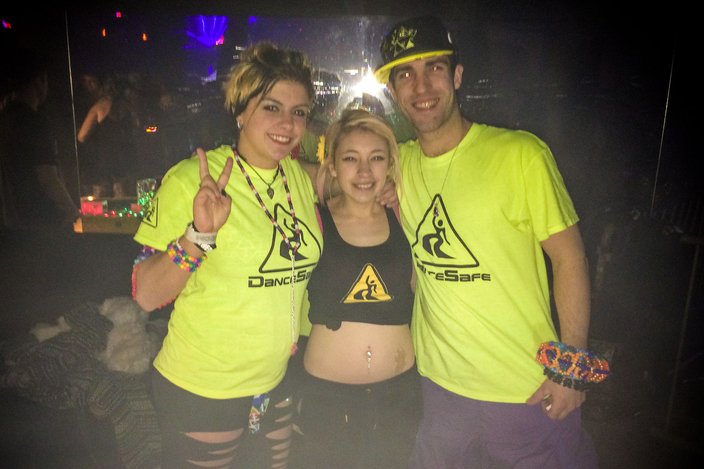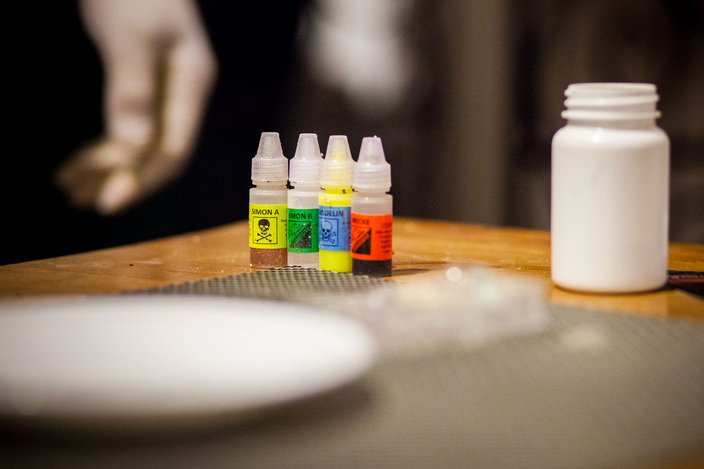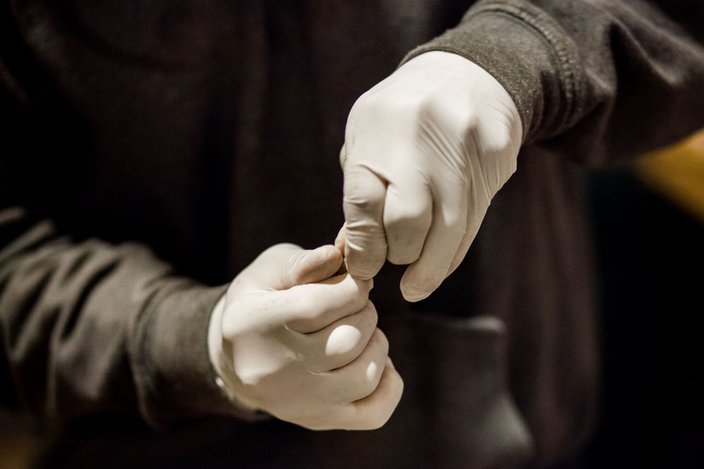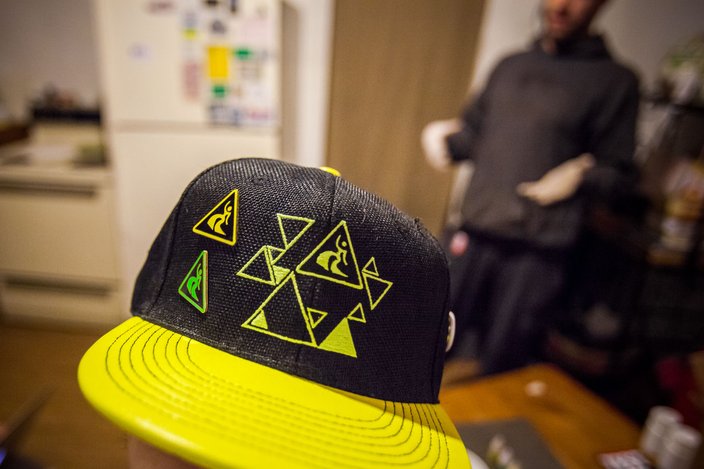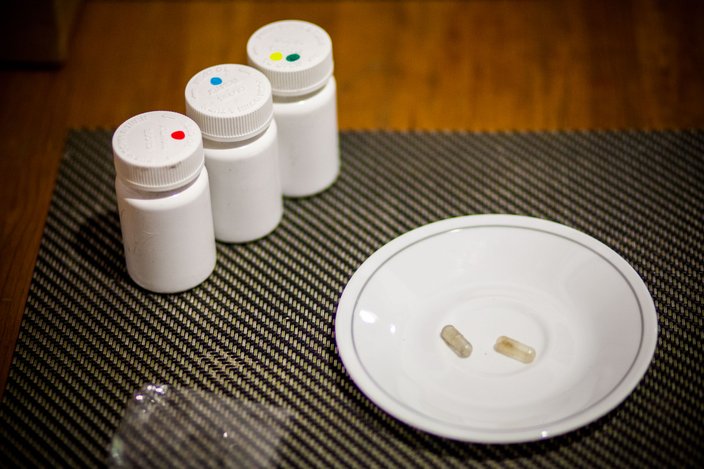Eric Keeley unpacks three bottles from a compact white box -- one that could just as easily contain a batch of cannolis or cupcakes. Emerging from the box is a set of four tiny dropper-bottles -- one yellow, one green, one blue and another red. He picks out the red bottle and dumps two pills from a baggy. His white-gloved fingers grip a capsule, cracking it open like a nut. He drops its innards, a handful of clear rocks, onto the center of a white saucer, where it blends in. With a tap-tap, a droplet plummets a few inches from the rocks. In seconds, the amber-red drop dirties the plate and wraps around the rocks; the liquid bubbles, its array of muddy colors expanding in the blotch like a universe stretching endlessly outward.
Finally, after 20 seconds pass, the liquid settles -- now a deep, static brown puddle, covering the rocks but no longer provoked by them.
This is what it looks like to test MDMA.
What is MDMA?
MDMA, sold under the street names of "ecstasy" and "Molly," is an illicit psychedelic and stimulant drug developed more than a century ago for use in psychotherapy. In its pure form, it increases neurotransmitter activity in the brain, speed-balling amounts of serotonin, dopamine and norepinephrine from neurons. The result is a three- to six-hour period of mood elevation.
In short, the problem at hand is this: People are buying what they think is MDMA and taking -- eating, snorting, drinking -- the drug like it's MDMA, but potentially ingesting a slew of different chemicals -- usually synthetic -- ranging from caffeine to cocaine. Synthetic substances like bath salts are particularly problematic, as not only can a user experience anything from high blood pressure, to paranoia, to kidney failure, but many synthetics remain unstudied.
This is where DanceSafe enters the stage.
DanceSafe is a harm reduction organization that only recently surfaced in Philadelphia. Its 17 national branches use test kits, which can be purchased by anyone for $65, to test for substance identity (not purity). A spokesman for the organization estimates that two to five new psychoactive drugs -- generally crafted to skirt drug laws -- can pop up each month. He told PhillyVoice.com it recently had to create 17 all-new information cards to circulate in an effort to keep up with synthetics that sprout like weeds.
DanceSafe, with its limited budget and largely volunteer-run base, is like the tortoise trying to make pace with the hare. Not to mention that its efforts are, pointing to the "Dance" half of its name, inextricably linked with an evolving, commercialized rave scene where MDMA and its ever-growing synthetic brotherhood have found a home.
In the Scene
"Yo, Philly! What the f--- is uppppp?! Time to get wonky!"
Thump. Thump. Thump.
It's a Tuesday night at
SoundGarden Hall, one of a handful of mainstream Philly rave-scene venues. Ears all around are invaded by the DJ's voice and the pulsating sound waves of trap music.The room smells of sweat and is mostly brightened by cellphone screens and neon-lit hula hoops ("Does anyone have batteries!?" screeches one panicked hula-hooper).
A quick scan of the room illustrates several hundred ravers clustered together -- a gaggle of 20-something, tank-topped "bros" getting a little too cozy with the gold-panty'd gal groping the pillar nearest them, a "
glover" performing for a tie-dye-shirt youngster who looks as if the shining beams of a UFO have just beckoned him from above ("It makes me feel powerful," the glover later tells me), a grown man dressed in a Cat in the Hat get-up and a woman in a bunny suit.
It's like an EDM- and drug-intensified Halloween.
But if you look to the very back of all this hoopla -- down the stairs from the station of five-dollar water bottles, that is -- you'll see what's intended to be the voice of reason: an (contextually) understated table decked out with cutesy drug information cards, a string of red and green LED lights and a group of men and women in their lime-green
DanceSafe T-shirts and baseball caps.
Behind the table is Bonnie Beaver, the first volunteer to hop on board with DanceSafe Philadelphia.
She explains what brought her to the organization.
"DanceSafe changed my life," she says, point blank. "I want to educate people on the stuff I did with ignorance -- and I was ignorant."
Beaver, who could, by her appearance, fool you as just another raver in the center of the dance floor, spent time in the Army in North Carolina before getting into the rave scene, where she says she "found her spirituality." Then she became introduced to MDMA through the rave scene -- and to her lover, a dealer who coaxed her into both dealing and using.
As a result, she also became one of those ravers who popped first and thought later.
- A self-professed "drug geek" shares his MDMA experiences
- "It hit me like a ton of bricks that I was a danger to everyone in my life," Read more.
"Back then, we were just taking Molly as it came -- it literally could have been anything," she says.
The relationship, she says, began to revolve around the drug. It quickly became emotionally abusive
So she fled North Carolina and moved to Philadelphia, where she met the chapter's founder, Eric Keeley, and was introduced to DanceSafe. Nor is she an anomaly: She's one of several DanceSafe volunteers who've had previous history with MDMA and have since abandoned their drug use.
Bonnie Beaver (left) and Keeley table the "Temple of Boom" rave event at SoundGarden Hall on Feb. 12. / Brandon Baker
Now, her goal is to keep young people from falling in the same hole she fell into.
"I'm not going to judge you or tell you not to take something, but no one should have to lose their son or daughter to this," she says, her voice stern and her eyes wandering over to an apprehensive-looking table-visitor. "We have the test kits -- test your stuff."
Dancing by an Egyptian-themed backdrop (there for selfies), just footsteps away from the DanceSafe table, is a woman with a flow stick in hand, the flaps of her bear-eared headdress bouncing against her back as she dances. She's hard to miss. She explains that she's been in the rave scene for five years ("It was a calling"), breaks down the rave-scene PLUR concept (Peace, Love, Unity, Respect) and demonstrates the hand signal for exchanging "Kandi" beads (think: wearable substitutions for rave photographs). She's 18.
Yes, she entered the rave scene at age 13.
Asked about her experience with the rave-scene drug culture since then, her response comes without a single word: Her mouth forms a coy smile, and her tongue peeks out to say hello. Lounging on it: a strip of LSD.
What is DanceSafe?
In 2013, Keeley, a Blue Bell, Montgomery County native, decided it was time to turn a new leaf.
"I used to be the one selling the drugs; I was the one throwing parties. Then I realized I was part of the problem," Keeley, founder of DanceSafe Philadelphia, told PhillyVoice.com. "The EDM scene, it's the only place I've ever felt whole. But I knew I had to step back, and I decided to get test kits and help people out. Then I got in touch with
DanceSafe, and realized Philly had no chapter."
In November 2013, Keeley started Philadelphia's branch of DanceSafe. Since December, he says he's accrued approximately 10 volunteers, all with a single mission: educating recreational MDMA users --
under the umbrella organization's long-standing motto of "neither condemning nor condoning drug use" -- of the risks that come along with consumption of the drug and its synthetic substitutes.
"Thing is, half of the recreational users in this country have consumed a drug other than MDMA without realizing it," Mitchell Gomez, outreach director for DanceSafe's national office, told PhillyVoice.com. "There are lots of recreational users who for the first time use a test kit and are astonished, and they've been using substances for a long time."
Keeley uses "Mecke" (red, far right), the most common of the four and a corrosive reagent, to test two substances thought to be MDMA. The changing colors of the liquid are paired with a color-coded chart to determine the actual drug contained in the crystals, pills and powders. Thom Carroll/PhillyVoice.com
To be clear, though, DanceSafe's marquee service, the MDMA drug-checking, is nothing new: DanceSafe's founder, Emanuel Sferios, who is no longer with the organization, began selling and using test kits shortly after he created the organization in 1998.
"I'd discovered that the Dutch government was offering pill-testing kits to users, and they were funding a harm reduction approach, because the market was so adulterated as a result of prohibition," Sferios told PhillyVoice.com. "There's no market as adulterated in the world as the ecstasy market. There are literally hundreds of other drugs -- newly synthesized, psychoactive drugs -- being sold under the name 'Molly,' and it's because the precursors, or what's obtained in order to make real MDMA, are controlled."
- DanceSafe founder Emanuel Sferios is working on a documentary film,"MDMA: The Movie." The feature film explores MDMA's history, its use in therapy and harm reduction. See the trailer here.
That part, though,
is new: Much of the MDMA popping up in the past five years -- see for yourself on the DEA-licensed
EcstasyData.org -- is actually Ketamine or a synthetic research drug banned by the DEA in 2011 called Methylone commonly known as a bath salt, which produces similar effects as MDMA but is chemically less understood.
MDMA in Philadelphia
The picture of how MDMA -- or its synthetic stand-ins -- is impacting Philadelphians is blurry: Drug intoxication fatality data collected by the Philadelphia Medical Examiner's Office does not specifically mention any MDMA overdoses, a Philadelphia Department of Behavioral Health representative told PhillyVoice.com, though it remains plausible that the substance could have been mixed with, or confused as, some of the Top 10 illegal substances reported by the office, which together account for 1,161 Philadelphia deaths in 2013.
What is clear, however, is that MDMA, or some variant of MDMA, is out there in the region, regardless of whether it's an epidemic or not. A spokesperson for the U.S. District Attorney of Eastern Pennsylvania told PhillyVoice.com that approximately half a dozen ecstasy distribution prosecution cases have been opened since 2010. 28-year-old Keeley, meanwhile, says he's tested thousands of pills and powders since he first purchased a test kit for his own personal use. "Eighty percent" of those, he says, test as something other than pure MDMA.
Keeley snaps open a capsule containing what was thought to be MDMA. / Thom Carroll, staff photographer for PhillyVoice.com
The biggest challenge for DanceSafe: Few venues will actually let test kits through the front door.
"At an event, very rarely will they let us test anything," Keeley said. "I'll table little [underground events] sometimes, and stuff at SoundGarden Hall or Penn's Landing. ... But most of the time, when I approach a venue owner, they'll immediately go, 'Ah, I can't [let you test], because it makes me legally liable.' And that's the only thing that could potential hold them legally liable under the RAVE Act."
The 'RAVE Act'
What Keeley and others refer to as the "RAVE Act" is actually the Illicit Drugs Anti-Proliferation Act, sponsored by then Senator Joe Biden as a ride-along piece of legislation tucked into the 2003 PROTECT Act. The law holds private venues responsible for drug use and perceived intent to distribute drugs at an event. In practice years later, it has inspired fear in venue owners who would rather play it safe by not allowing well-intended organizations like DanceSafe into their parties -- or even basic harm-reduction amenities like water stations.
Access to free water at raves and festivals surfaced on the agenda after two fatalities from MDMA-induced cases of hyperthermia -- or overheating -- at the 2013 Electric Zoo Festival in New York. Because both overheating and overhydrating (counter-intuitive, but true) are associated causes of death for an MDMA overdose, having a free water station onsite can look incriminating for a venue.
"Water was a
big bone of contention at the
Electric Zoo incident ... they disallowed people to bring in camelbacks, the refillable hydration packs, and one thing they had to concede this year was to allow those," says Tammy Anderson, a University of Delaware associate professor of sociology who's
studied the Philadelphia rave scene. "The reason for that is the business and culture of it. You see, the rave culture has never valued alcohol. So, if you're a promoter, how are you going to make money, especially if DJs ask for thousands of dollars? All you have is entrance fees -- it's not like a hip-hop club, with bottle service and alcohol."
Tammy Anderson: "... the rave culture has never valued alcohol. So, if you're a promoter, how are you going to make money, especially if DJs ask for thousands of dollars? All you have is entrance fees -- it's not like a hip-hop club, with bottle service and alcohol."
Actually leveraging charges under the "RAVE Act" is a much, much more complicated endeavor.
To date, there are no known cases in the region that specifically cite the Illicit Drug Anti-Proliferation Act; a representative from the Philadelphia District Attorney's office told PhillyVoice.com that charges are more likely to fall under "Possession or Intent to Deliver," or, if minors are on the premises, "Endangering the Welfare of a Child." (It's worth noting that all-ages rave events aren't unheard of.)
One proponent of amending the Illicit Drugs Anti-Proliferation Act is DanceSafe founder Sferos. Though the act may have had its merits in the beginning, it now interferes with DanceSafe's access to events.
"We need to take a public health approach to recreational drug use," Sferios says. "Prior to the RAVE Act, when I started DanceSafe, we had relationships with local police, health departments, and they knew what we were doing. We had 24 chapters, and maybe two-thirds were doing testing, and the only time they weren't, was when promoters weren't allowing it -- and the ones who didn't allow it, generally were the ones involved in illicit drug sales."
Reducing Harm
Harm reduction accepts the notion that people will engage in risky behavior like taking drugs, and that the best practice is to reduce negative consequences through education and non-judgmental interventions.
"Our drug policy throughout the country has always been 'put your head in the sand' on this issue," Jose Benitez, executive director of Prevention Point, told PhillyVoice.com. "It's a false argument that if you teach risk reduction that you're encouraging risky behaviors. People are going to take risks, and we're here to minimize what those are."
Historically, Philadelphia has led the way with harm reduction efforts.
Turn back the clock to 1992, a moment in time when scenes from the film "Philadelphia" were all too real: The World Health Organization estimated nearly 11 million men and women had been infected with HIV, and Philadelphia's bent for illicit drug use wasn't making the scene particularly pretty in city limits.
Thus, Mayor Ed Rendell issued an executive order, one that made a special exception for a needle exchange program -- probably the most popularly known and controversial form of harm reduction -- that is, to this day, headed by
Prevention Point, despite being unequivocally illegal under Pennsylvania law.
Keeley's cap, featuring the DanceSafe logo, which he wears when he tables dance events. / Thom Carroll, staff photographer for PhillyVoice.com
The harm reduction debate ultimately comes down to the same argument that's led the sex-ed back-and-forth for decades: Does a lesson plan that includes information about condom use and birth control (read: harm reduction) only encourage harmful behaviors (read: drug use)?
An Undetectable Crisis
At present, the MDMA epidemic -- if it is one at all -- is being measured in headlines.
Which is all to say this: What will it take for Philadelphia to circumvent the Illicit Drugs Anti-Proliferation Act, as it did with needle exchanges?
Narcotics officer Michael Paine of the Philadelphia Police Department told PhillyVoice.com that its present level of concern regarding the spread of MDMA and its substitutes in Philadelphia is "neither high nor low." He also clarifies that the department does pay close attention to what's happening at universities, as they're less likely to inform the department of any problems for the sake of maintaining a drug-free image. The Philadelphia DEA refused detailed comment on MDMA, only to say that they're "aware" of the problem, and that heroin, "pills" and cocaine are the drugs at the top of the administration's agenda in Philadelphia. (Which might explain why its Forensic Testing Lab only has MDMA at No. 23 on its list of most-commonly-detected 2013 drugs in Philadelphia -- they only test what they confiscate and take the time to monitor, after all.)
The current estimate has national MDMA overdoses at about 15 per year, according to Sferos' research. In Philadelphia, the Medical Examiner's Office reports detections of three substances commonly confused as MDMA: In 2013, there were 15 detections of methamphetamine, three of methylone and three of MDA, but no additional context is provided for the numbers. Numbers tend to be elusive because of how adulterated the market is. It's not that the overdose or health-impact numbers are low, per se; it's that they barely even exist. So, it's not altogether surprising that MDMA harm reduction is toward the bottom of the list on the agenda. Two capsules, which are tested to be methylone (left) and MDA (right), rest atop a clean saucer. / Thom Carroll, staff photographer for PhillyVoice.com
No Judgment
Look, it's difficult to face someone who's immersed themselves in a culture of drugs at such a ripe age -- see: the 18-year-old raver mentioned above -- and
not want to judge, especially with
DAWN data suggesting there's been as much as a 128 percent increase in ecstasy-related emergency room visits from those younger than 21. But what's to be understood, is that judgment is not DanceSafe's M.O. -- the organization's not the slightest bit kidding with its "we neither condemn nor condone" spiel.
"Using drugs is just a biological reality of our species. There are groups of people who, no matter what the consequences will use drugs. And you have to accept that," Gomez says. "'How do we make these lives safer?' should be the starting point, and not a preexisting judgment value that we should do everything we can to stop drug use."
Gomez says an ideal scenario would be to have funding for more complex, portable testing machinery, and cooperation from county governments to open a clinic with objectives akin to those of Prevention Point's -- that is, to have a secure space where people can, for safety purposes, test their drugs without judgment or fear of law enforcement.
Though, he says, that's at least five years off.
"I hope I'm wrong, though, and I hope we can get every major city in the country to have a day and time for people to bring their drugs through a machine, which they already do in places like
Portugal and Spain," Gomez says. "We're just behind on harm reduction on outreach."
So, in the meantime, he and a group of DanceSafe directors are finishing up plans on beefing up that educational outreach for informing young people -- who don't exactly grow up with a model for how to safely take drugs, as they might with alcohol -- how to reduce their risks. They're prepping a six-week training program they plan to offer to volunteers in the summer under the
Visionaries program, which, in content, targets a new (and presumably younger) volunteer audience.
I hope we can get every major city in the country to have a day and time for people to bring their drugs through a machine, which they already do in places like Portugal and Spain," Gomez says. "We're just behind on harm reduction on outreach."
Keeley, meanwhile, hopes to be able to do more testing at outdoor festivals this season, where he says he often has better luck convincing promoters to let him table. (Most recently,
Opple Topple Festival in Doylestown, Bucks County.)
"There are people out there who don't even know about us, and that's what I'm trying to change right now," Keeley says, after sharing a litany of stories of witnessed dance-floor seizures.
"For Philly, specifically," he says, "the need for this is long past due."
*Full names were not used in certain instances to protect the identity of those involved with drug use.

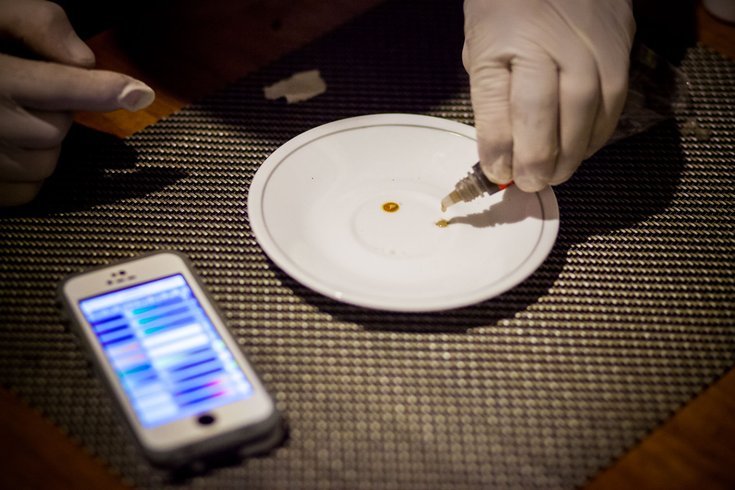 Thom Carroll/for PhillyVoice
Thom Carroll/for PhillyVoice
